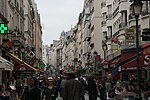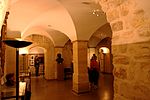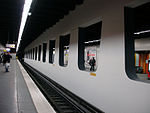Au Rocher de Cancale
1804 establishmentsBuildings and structures in the 2nd arrondissement of ParisFrench restaurantsMonuments historiques of ParisRestaurants in Paris

Au Rocher de Cancale is a restaurant located in the 2nd arrondissement of Paris, France. It was very popular in the 19th century thanks to its suppers offered after theatre and opera shows.
Excerpt from the Wikipedia article Au Rocher de Cancale (License: CC BY-SA 3.0, Authors, Images).Au Rocher de Cancale
Rue Montorgueil, Paris 2nd Arrondissement (Paris)
Geographical coordinates (GPS) Address External links Nearby Places Show on map
Geographical coordinates (GPS)
| Latitude | Longitude |
|---|---|
| N 48.86559 ° | E 2.347153 ° |
Address
Au Rocher de Cancale
Rue Montorgueil 78
75002 Paris, 2nd Arrondissement (Paris)
Ile-de-France, France
Open on Google Maps









